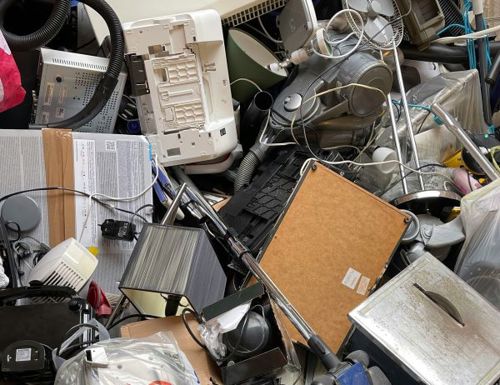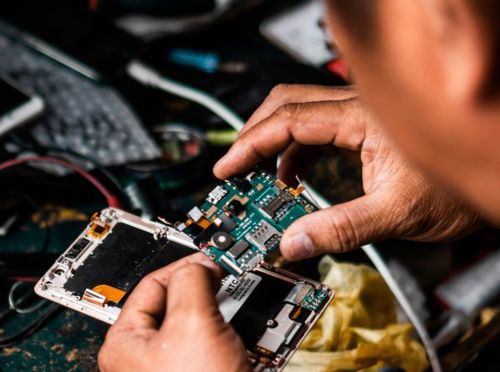Statistics around electronic waste paint an alarming picture as the UK’s contribution to the global issue is expected to worsen. As the second highest generator of e-waste per capita in the world, the UK is estimated to have produced 46,557 tonnes of e-waste through 2023 and is on track to overtake Norway in the rankings to become the worst offender in 2024.
More widely, the global electronics industry accounts for roughly 4% of total greenhouse gas emissions, and as the fastest-growing waste type, e-waste is forecasted to increase by as much as 30% by 2030.
It’s not just the scale and pace of e-waste generation that raises alarm bells. It’s estimated that just 17% of e-waste is recycled globally, leaving a colossal amount that’s being sent to landfill, incinerated or illegally exported, causing significant damage to people and the planet. This damaging reality doesn’t bode well for the UK’s likelihood to meet Net Zero targets, let alone the global effort.
The circularity gap
Much needs to be done to tackle the mountainous issue of e-waste. This includes better choices through design and manufacture, end-of-life measures, and steps to prolong the lifespan of devices and appliances in the first place. Although consumers have a role to play in changing their purchase, usage and disposal behaviours, it’s manufacturers that must make the first move.
While there’s generally better education and increased awareness around sustainability and its importance, the Circularity Gap Report demonstrates a real disconnect between attitudes and real action and progress being made. Current rates of extraction of virgin materials are unsustainable and rebalance is critical. While they make up just one part of the wider problem, manufacturers must rethink their approach to electronics. Real, impactful change can only come from a fundamental shift in attitudes and supply chains to bring circular innovation to the forefront.

The Right to Repair
Consumers have long been sceptical of ‘planned obsolescence’ - the idea that electronics are purposely designed and manufactured to have a short lifespan. Or the idea that software updates deliberately slow devices down or are incompatible with the hardware so consumers must replace devices or appliances. Essentially encouraging consumers to spend more money with the manufacturer more regularly.
However, we have seen steps in the right direction when it comes to white goods through the introduction of the ‘Right to Repair’ law. The legislation was designed to tackle obsolescence and encourage consumers to get their appliances repaired rather than replaced. Applying to purchases from 1st July 2021, the law states that white goods should be repairable by ‘commonly available’ tools and that manufacturers must give professionals access to spare parts and repair documentation for up to ten years after purchase.
Since the implementation of ‘Right to Repair’, The European Commission has introduced new rules to ensure that smartphones and tablets are also designed with repairability in mind. However, these would not apply to the UK as domestic discussion largely centres around the correct disposal of electrical goods rather than an entirely circular approach.
Meanwhile, there are many issues hampering consumers from being able to get their devices repaired or prepared for the secondary market. While it was once possible to harvest and reuse older smartphone parts to create new functional devices, this is becoming increasingly difficult. Take the iPhone for example - the most popular smartphone in the world, yet the most difficult to repair. Apple’s latest smartphone hosts software that causes warning messages to pop up or functionality to be lost if parts are replaced with new ones that weren’t purchased directly from the manufacturer.
While many major manufacturers would argue that they offer avenues to expand the lifespan of handsets through self-repair programmes, at current rates these usually cost more than the worth of the fully repaired device. This means they’re often deemed unfeasible or simply ‘not worth it’. Available repair routes typically don’t fall in the consumer’s favour and only strengthen the monopoly of the manufacturer.

The current state of play is similar in the white goods space despite legislative changes. When it comes to our fridges and freezers, cookers and laundry appliances, breakdowns and downtime are highly inconvenient, and we often can’t afford to wait or ‘manage’ without them. Many appliance faults require customers to wait for manufacturer-approved technicians to attend and diagnose a fault. Even then, dismantling the machine, and ordering and fitting replacements can be a complex and time-consuming process. Not opening up the ability to repair to capable third parties can discourage consumers from repairing perfectly good devices and can instead see them send devices straight to landfill and purchase a brand-new model.
Strategies to increase the lifespan of electronics
If we are to see meaningful change to the volume of e-waste the UK produces, manufacturers have an ethical obligation and opportunity to implement circular practices. As well as making appliance manuals and parts available, manufacturers can make a significant difference by making small changes through the design process.
Design for sustainability and circularity must be considered right at the beginning of the process through the selection of raw materials with a lower environmental impact. It’s important to consider these materials’ end-of-life at the beginning of the process. Manufacturers should opt for recyclable or renewable materials and try to reduce the use of glues in construction wherever possible. However, it’s also important to balance these considerations with requirements for durability and reliability – what’s going to give the device or appliance a longer lifespan?
Localised material sourcing and production can also help reduce carbon emissions at this stage. Opting for lightweight materials or compact units can help to reduce transport costs and emissions too.
When it comes to design, manufacturers should consider incorporating easily repairable and replaceable modules to extend the product’s lifespan through maintenance and upgrades. If there are parts or elements of the machine or device that are likely to need replacing or maintenance more frequently, ensure that they can be easily accessed and removed or repaired as required.
In addition, to help reduce the volume of improperly managed e-waste, manufacturers should consider introducing recycling or take-back schemes, which would enable them to recover and reuse materials to reduce costs and the requirement for extraction and purpose of new materials.
Conclusion
Effectively tackling the e-waste challenge requires concerted efforts from all parties. It needs legislation from the top, education and buy-in from industry bodies, responsibility and awareness among consumers, and importantly, a commitment to change and ethical and progressive design from manufacturers.
The onus and the ability to design electronics that stand the test of time firmly sits with manufacturers. This, in turn, makes it easier for consumers to make decisions that are better for the environment.
Sustainability and circularity should not only be viewed as a necessary change for the future, but an opportunity to source materials more responsibly, realise cost efficiencies, increase customer trust and loyalty, collaborate with suppliers and stakeholders throughout the supply chain, and design for continuous improvement and innovation.
Author details: James Rigg, CEO of Trojan Electronics













